Dec 5, 2022
Arabic Language 01
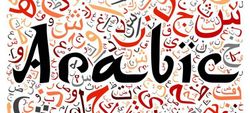

What are the historical origins of the Arabic writing system? This graphic helps examine the link between earlier alphabets and how they developed into the Arabic alphabet we know today, while also exploring how other languages from completely different language families use the Arabic alphabet as their primary writing system. Featured below is a selection of letters from each alphabet and how they have evolved throughout history.

Infographic: Arabic Influence on the Spanish Language:
In 711 CE the Arabic-speaking Umayyad dynasty began their conquest of the Iberian peninsula, now present-day Spain. During this time, there was over 800 years of Arab cultural and linguistic influence on the region. Today, over 4,000 Spanish words derive their origins from Arabic. This graphic showcases a sample of some of the most commonly used Arabic loanwords, comparing cafes found in both the Arabic and Spanish speaking world.
In 711 CE the Umayyads, a powerful Arab dynasty, began their conquest of the Iberian peninsula, what is now Spain. During this time, there were over 800 years of Arabic cultural and linguistic influence in the region. Today more than 4,000 Spanish words derive their origins from Arabic. This chart shows some of the Spanish words that derive their origin from Arabic, comparing coffees found in the Arabic and Spanish-speaking world.

Infographic: Non-Verbal Communication in the Arab World
Language and culture are intertwined, which makes non-verbal communication a key aspect in language learning. Not all communication is language-based; people also convey what they’re thinking using gestures, eye contact, and facial expressions. Understanding differences in non-verbal communication is a vital part of building cross-cultural relationships. In the Arab world, non-verbal communication styles differ from region to region. Here are six commonly-used gestures that you may see in the Arab world. Think about the non-verbal communication you use in your life. How do these gestures compare?

Soccer (Football) plays an important cultural role throughout the Arab world, draws millions of fans each year, builds unity among people in the North Africa & Middle East , and consistently ranks as the region’s most-watched sport.

Infographic: The Spectrum of Love in Classical Arabic
The word for “love” appears throughout Arabic literature in many forms. Arabic views love as a complex spectrum, containing several various stages. These stages begin with inclination and infatuation, and in the final stages, end with losing one’s mind. While some of these words imply tenderness, others denote a love sometimes so strong it hurts. This graphic displays 14 increasingly strong stages of how the Arabic language expresses the idea of love.

Infographic: The Traditional Arab Ensemble
The traditional Arab ensemble is known as ‘takht’ (literally meaning “bed” in Arabic).
The composition of the ensemble may vary, but it is typically composed of the following six melodic instruments: the ‘oud, qanun, nay, kamanja, riq, and darbuka. The ensemble may be joined by male or female vocalists.
The takht ensemble employs the use of quarter tones in addition to whole and semi-tones, which gives the takht its unique and melodramatic sounds.
This infographic provides an overview of the instruments that make up the traditional Arab ensembles.
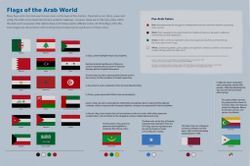
Infographic: Flags of the Arab World
Many flags within the Arab world share colors on the basis of Pan-Arabism. Denoted by red, black, green and white, Pan-Arab colors have historical and symbolic meanings. However, these are not the only colors within the Arab world as several other nations have a rich history tied to different colors.
This infographic displays all of the flags within the Arab League along with a brief synopsis explaining the significance of these colors.

Infographic: Arabic Letters and Sounds
All languages have specific sounds that convey meaning when combined. Each sound has a specific place and manner of being produced in our mouths. The Arabic language has 28 specific phonemes, which are the building blocks of any Arabic word. In Arabic, unlike other languages such as English or French, each phoneme matches with a specific letter.
This diagram displays all 28 consonant letters of Modern Standard Arabic and where they are produced in the mouth.
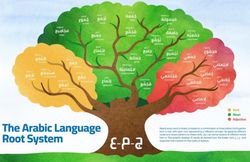
Nearly every word in Arabic is based on a combination of three letters that together form a root, with each root representing a different concept. By applying different vowel and stress patterns to these roots, you can derive dozens of different words from it. This graphic displays 31 words all derived from the Arabic root , ج م ع and organizes them based on their parts of speech.
How many roots are there in Arabic?
by Arabic Online | Aug 9, 2017 | Arab World, Arabic Language | 0 comments
Most words in the Arabic language are derived from a root. A word is created by applying vowels, prefixes and suffixes in an often predictable manner to the original root. According to Karen Ryding in ‘A Reference Grammar of Modern Standard Arabic’, there are between 5,000 and 6,500 lexical roots in Arabic.
Each lexical root is a combination of usually three letters. For example the root m-l-k conveys the concept ‘to possess’. From this root, the Arabic language derives numerous other words related to the concept such as: owner, property, king, realm, royalist, transfer of ownership and talent! A cursory glance at the English words indicates that all of them are very different. In Arabic all words contain the same three letters, making the words easily recognisable. The letters must be in the same order.
The root system found within Semitic languages has been described as one of the “great miracles of man’s language” (Lohmann). It is logical and mathematical and unsurprisingly the Arabs are mighty proud of their ‘verbal miracle’.
There is also a joke about this miracle – every root means four things: its basic concept, the opposite, something related to a camel or horse and something so obscene you need to look it up for yourself. An example is the root j-m-l.
Naturally, any Arabic learner will realise that this is an exaggeration but, nonetheless, the Arabic learner will gain a lot of enjoyment by looking up an Arabic root and learning about all the different words – often surprising and sometimes rude.
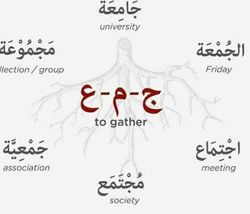

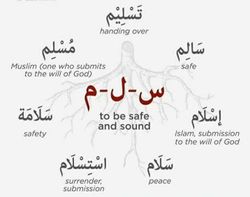

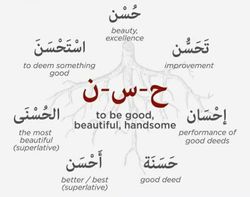
Questions Matching Game
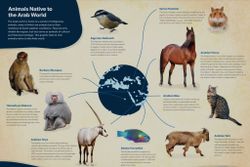
Infographic: Animals Native to the Arab World
The Arab world is home to a variety of indigenous animals, many of which are unique due to their resilience to harsh weather conditions. They not only inhabit the region, but also serve as symbols of cultural and historical heritage. This graphic feature nine animals native to the Arab world.
This infographic provides an overview of animals indigenous to the Middle East.
There is a game accompanying this resource as a supplemental file. Use the numbered English translations to match the animal to the region they are from.
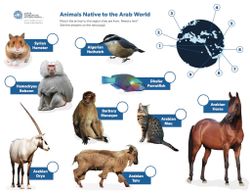
Infographic: Native Flora from the Arab World
Flowers have long been an important facet of national identity. In the Arab world, floral motifs and patterns decorated architecture and objects from the earliest Islamic period and even further back. They featured in Arabic calligraphy, ceramics, and textiles. Floral scents recall subconscious and shared experiences, a reminder suffused with nostalgia for place and identity. The importance of national flowers is found not only in daily life but also in the values and culture of a community.
This infographic provides an overview of the native flora of the Middle East.
There is an accompanying game for students to play in the classroom. To play the game, use the numbered English translations to match with the Arabic word.
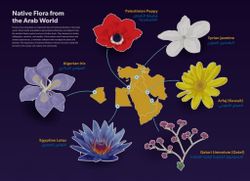

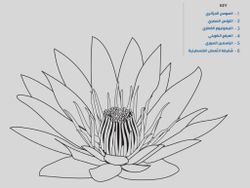
Arabic Roots links
https://en.m.wiktionary.org/w/index.php?title=Category:Arabic_roots&pagefrom=%D8%B3+%D9%86+%D9%88%0A%D8%B3+%D9%86+%D9%88#mw-pages
https://wahiduddin.net/words/arabic_glossary.htm
https://medium.com/@aymannadeem/arabic-trilateral-roots-3186e8319b0
https://arabiconline.eu/how-many-roots-arabic-language/
By undefined
34 notes ・ 99 views
Arabic
Beginner